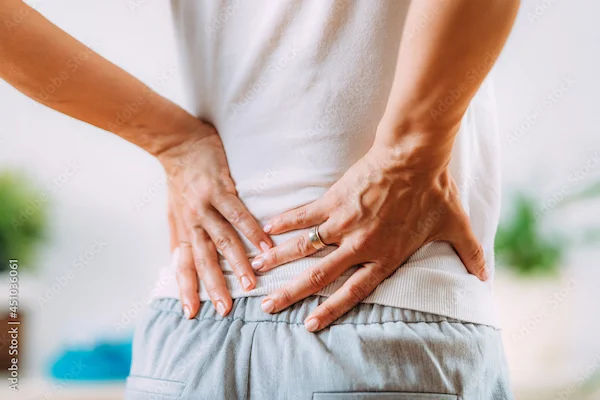Understanding Lower Back Pain: Causes & Solutions
Learn about the common causes of lower back pain and discover simple, effective solutions to relieve discomfort and prevent future problems. Stay active, correct your posture, and know when to seek medical help.

Written by Dr. Rohinipriyanka Pondugula
Reviewed by Dr. Mohammed Kamran MBBS, FIDM
Last updated on 28th Jul, 2025

Introduction
Lower back pain is a common issue that affects millions of people worldwide. Whether it’s a dull ache or a sharp, stabbing pain, it can disrupt daily life and limit mobility. The good news is that most cases of lower back pain are not serious and can be managed with simple treatments and lifestyle changes. In this article, we’ll explore the causes, symptoms, and solutions for lower back pain in an easy-to-understand way.
What Causes Lower Back Pain?
Lower back pain can arise from various factors, including muscle strain, poor posture, injuries, or underlying medical conditions. Here are some common causes:
1. Muscle or Ligament Strain: Lifting heavy objects, sudden movements, or overstretching can strain the muscles and ligaments in the back.
2. Poor Posture: Sitting or standing incorrectly for long periods can put stress on the spine.
3. Herniated or Bulging Discs: The soft cushions (discs) between the spinal bones can bulge or rupture, pressing on nerves.
4. Arthritis: Osteoarthritis can affect the lower back, leading to stiffness and pain.
5. Sciatica: A pinched nerve in the lower spine can cause sharp pain that radiates down the leg.
6. Osteoporosis: Weak bones due to aging or calcium deficiency can lead to fractures and back pain.
7. Sedentary Lifestyle: Lack of physical activity weakens back muscles, making them prone to injury.
Common Symptoms of Lower Back Pain
Lower back pain can vary in intensity and duration. Some common symptoms include:
Dull, aching pain in the lower back
Stiffness or reduced flexibility
Sharp pain when moving or bending
Pain that spreads to the hips, buttocks, or legs (in cases of sciatica)
Muscle spasms or tightness
If your pain is severe, lasts more than a few weeks, or is accompanied by numbness, weakness, or loss of bladder/bowel control, seek medical attention immediately.
How to Manage and Prevent Lower Back Pain
Here is how you can manage and prevent lower back pain:
1. Stay Active
Contrary to popular belief, rest alone isn’t always the best solution. Gentle movement helps maintain flexibility and strength. Try:
Walking: A simple 20-30 minute walk daily can improve circulation and reduce stiffness.
Stretching: Gentle stretches for the hamstrings, hips, and lower back can relieve tension.
Yoga or Pilates: These exercises strengthen core muscles, which support the spine.
2. Improve Posture
Sitting: Keep your feet flat on the floor, back straight, and shoulders relaxed. Use a lumbar support cushion if needed.
Standing: Distribute weight evenly on both feet and avoid slouching.
Sleeping: Use a medium-firm mattress and sleep on your side with a pillow between your knees for spinal alignment.
3. Strengthen Your Core
Strong abdominal and back muscles provide better support for the spine. Try exercises like:
Planks
Bridge pose
Pelvic tilts
4. Maintain a Healthy Weight
Excess weight puts extra pressure on the spine. A balanced diet and regular exercise can help manage weight and reduce strain on the back.
Health topic carousel:
Doctor's speciality: General Physician
Text: Consult a Top General Physician for the best advice
5. Apply Heat or Cold Therapy
Ice packs (for the first 48 hours after an injury) reduce swelling.
Heating pads (after 48 hours) relax tight muscles and improve blood flow.
6. Avoid Heavy Lifting
If you must lift something heavy:
Bend your knees, not your waist.
Keep the object close to your body.
Avoid twisting while lifting.
When to See a Doctor
Most lower back pain improves with self-care, but consult a doctor if:
Pain lasts more than 4-6 weeks.
Pain is severe and doesn’t improve with rest.
You experience numbness, tingling, or weakness in the legs.
There’s unexplained weight loss or fever (could indicate an infection).
At Apollo 24|7, you can book a consultation with a spine specialist or physiotherapist for personalized care. Early diagnosis and treatment can prevent complications.
Conclusion
Lower back pain is common but manageable. By staying active, maintaining good posture, and making simple lifestyle changes, you can reduce discomfort and prevent future issues. If pain persists, don’t hesitate to seek professional help.
Health topic carousel:
Doctor's speciality: General Physician
Text: Consult a Top General Physician for the best advice




